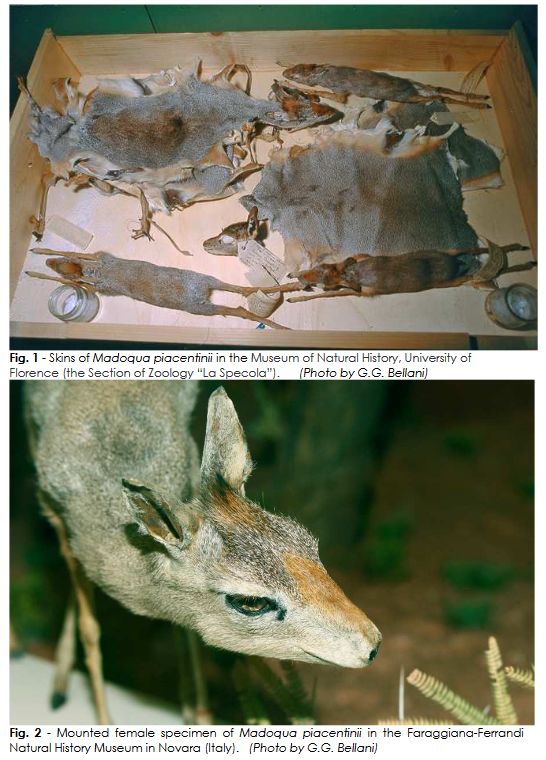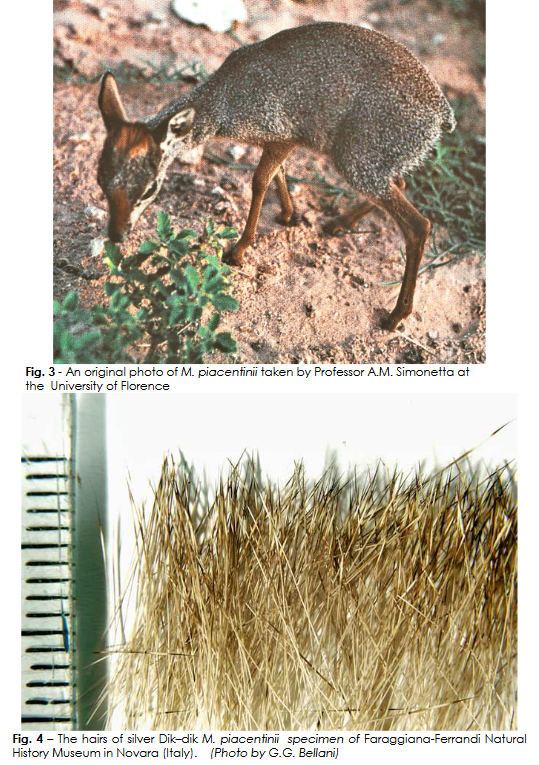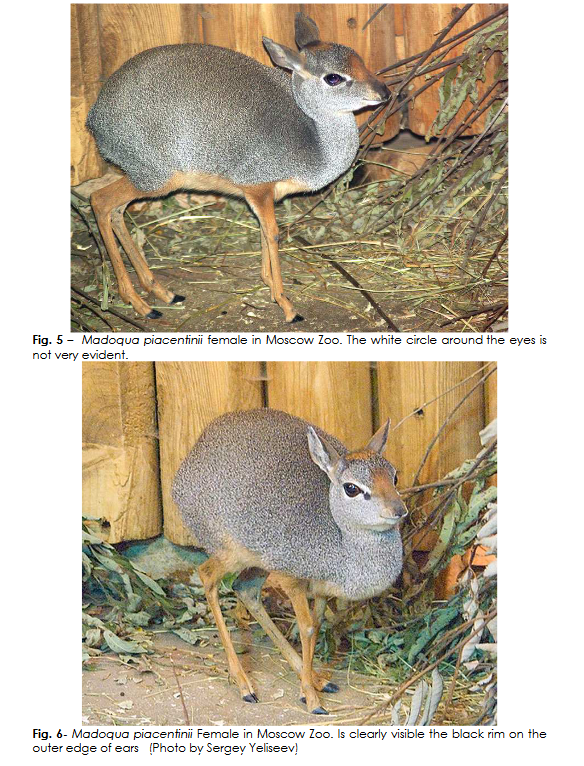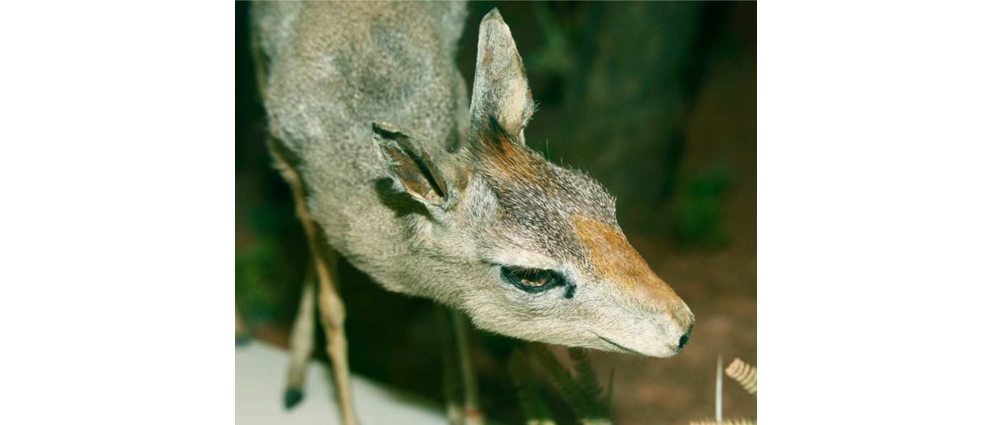Notes on the silver Dik-dik Madoqua piacentinii Drake-Brockman, 19111
GNUSLETTER I.U.C.N. / A.S.G. Antelope Specialist Group February 2013 VOL. 31
Giovanni G. Bellani, 10 aprile 2013
The dik-diks (genus Madoqua) are small antelopes mainly living in North-east and East Africa, with an outlying population in Namibia and Angola. They are characterized by small size and the structure of the premaxillary and nasal bones which give a distinctive appearance to their face: the nose is crooked, rather ‘long and mobile, with nostrils that often protrude forward from the chin. Another characteristic of the group is the erectile tuft of long hairs on the top of the head that often conceals the short horns of the males. Four species are recognized by Yalden (1978) and Grubb (2005) and a number of subspecies and forms have also been named (Table 1). There is chromosome and ecological evidence that Madoqua kirkii, is a complex of four species, M.damarensis in Namibia and Angola, and three species, M. cavendishi, M. kirkii and M. thomasi in East Africa (Kingswood et al. 1994, Kingswood and Kumamoto 1997, Kingdon 1997). In a more radical arrangement, Groves and Grubb (2011) recognized 13 species of dik-diks.

Silver dik-dik
Silver dik-dik M. piacentinii is the least-well known of these forms, and is one of the very few antelopes classified on the IUCN Red List as Data Deficient (Antelope Specialist Group 2008). Silver dik-dik has sometimes been regarded as a subspecies of M. saltiana (Meester & Setzer 1974, Bellani 1997) but is more usually classified as a full species (Funaioli & Simonetta 1960, Yalden 1978, Grubb 2005).
Its range was originally believed to be restricted to the central coastal plain of Somalia, where it extended for no more than 10 km inland (Simonetta 1988, East 1999). East (1999) estimated this range at about 15,000 km2, and its density at 2/km2 and thus a maximum population of 30,000. No field surveys have been carried out in this region for over 20 years. Recently, silver dik-dik was reported and photographed in the Ogaden of Ethiopia (Wilhelmi et al. 2006), where it occurred sympatrically with M. guentheri and M. saltiana. Wlhelmi et al. (2006) estimated that its distribution in the region extended from 60 km south of Kebri Dehar to Wadi Shebelle and possibly eastwards to the Somali border, but that it was much less common than the other two species. This finding indicates that the species is more widely distributed than previously thought. Access to the Ogaden region is restricted, so field surveys are not possible at present. In Somalia, silver dik-dik occurs in dense low coastal thickets on fertile, sandy soils under an offshore wind that has a cooling effect (Kingdon 1997) and in the Ogaden, in dense Acacia-Commiphora bushland (Wilhelmi et al. 2006).
Identification
Yalden (1978) distinguished M. piacentinii on the basis of consistently smaller size, uniformsilvery coat color, and length of the upper tooth row. In order to supplement this information, to further investigate differences in coat color and to aid identification of individuals in the field or in collections, the following specimens and materials were examined:
– Skins of M. piacentinii from the collection of the Museum of Natural History, University of Florence, Department of Zoology “La Specola” (Fig. 1 skins of Florence),
– Three specimens classified by me and part of the collection Faraggiana-Ferrandi in the Museum of Natural History in Novara (Italy) (Fig. 2 mounted specimen of a female)
– An original photo of M. piacentinii taken by Professor A.M. Simonetta at the University of Florence (Fig. 3).
Distinguishing features are:
– M. piacentinii is always smaller than saltiana (Head and body 45-50cm in piacentini and52-67 cm in saltiana.
– In M. piacentiniithe individual hairs are black at the tip, then a clear band almost creamy-white, and another band of dark brown that sometimes ends with a short reddish tinge; the rest of the hair is unicolored. The area of alternating light and dark bands is never longer than 5 mm, while the area of alternating color bands on the hairs of M. saltiana,always exceeds 5 mm (Fig. 4).
– M. piacentinii has a reddish tuft on the top of the head and a reddish spot on the nose, usually separated by grey fur on the forehead (see photos) In M. saltiana, the red color on the head forms a single patch and the forehead is largely reddish.
– The ears are proportionately smaller and the outer edge has a black rim (Yalden 1978), though M.saltiana sometimes also shows this feature.
– In M. piacentinii the white circle around the eyes is less apparent than in M. saltiana.
Conservation
De Georges & Reilly (2009) reported that in the 1960s, 350,000 skins of dik-diks per year were exported from Somalia to Europe. Amir (2006) also considered silver dik-dik to be among the species subject to capture and illegal export (along with other species of Somali antelopes). There is very little specific information available on population trends. Wilhelmi et al. (2006) considered that though less abundant than other dik-dik species in the Ogaden, it seemed to be stable, and they classified its regional status as not threatened. There are no protected areas within its known area of distribution. Although many potential threats are operative (hunting and poaching for meat and skins, capture for export of live animals, overgrazing and degradation of habitat) their impact is unknown and the resilience of the species cannot be assessed.
Until recently, it was believed that there were no specimens in captivity. However, Moscow Zoo has recently been shown to hold a small number of silver dik-diks, based on the identification characters detailed above (Figs. 5-6). Unfortunately there are no precise details of the origin of these animals and there are too few to form a robust captive breeding population.
Given the political and economic situation in Somalia, and the situation in the Ogaden, it is unrealistic to hope for even a minimum involvement by government bodies in its conservation. Establishing its actual distribution and population size is urgently needed, but field surveys are likely to remain impractical for the near future at least. One much needed – and realistic – initiative is a detailed analysis of the DNA of Madoqua to clarify the relationship between M. piacentinii and M. saltiana, and the number of distinct taxa within the genus overall and their relations to each other.
Acknowledgements
I am grateful for the help of the following: The Museum of Natural History Faraggiana-Ferrandi in Novara (Italy), The Museum of Natural History, University of Florence (in particular the Section of Zoology “La Specola”), Professor Alberto M. Simonetta, Mr. Sergey Yeliseev and Mr. Nicolay Usik for their photo of specimens at the Moscow Zoo, Dr David Mallon.
References
Amir, O. G. (2006) Wildlife trade in Somalia 2006. A report to the IUCN/SSC/Antelope Specialist Group – Northeast African Subgroup.
Bellani, G.G. 1997. Grandi Mammiferi Africani. Collana Tutto A.Mondadori ed. Milano.
De Georges P. A., Reilly B. K. 2009. The realities of community based natural resource management and biodiversity conservation in Sub-Saharan Africa. Sustainability 1:734-788.
East, R. 1999. African Antelope Database 1999. IUCN, Gland, Switzerland and Cambridge, UK.
Funaioli, U. & Simonetta, A.M. 1960. Spedizione biologica in Somalia 1959. Risultati zoologici II, Monitore Zool. Ital (1-2): 58-89.
Groves C. & Grubb P. 2011. Ungulate Taxonomy. Johns Hopkins University Press, Baltimore.
IUCN SSC Antelope Specialist Group 2008. Madoqua piacentinii. In: IUCN 2012. IUCN Red List of Threatened Species. Version 2012.2. <www.iucnredlist.org>.
Kingdon, J. 1979. East African Mammals. An atlas of evolution in Africa. Vol. III Part C. Academic Press, New York.
Kingdon, J. 1997. The Kingdon field Guide to the African Mammals Academic Press New York. Kingswood, S.C. & Kumamoto, A.T. 1997. Madoqua kirkii. Mammalian species 569.
Kingswood, S.C., Kumamoto, A.T. & Wouter, H. 1994. Chromosomal divergence in allopatric populations of Kirk’s dik-Dik Madoqua kirki (Artiodactyla, Bovidae).Journal of Mammalogy 75: 357-364.
Meester, J. & Setzer, H.W. 1974. The Mammals of Africa. An identification manual, Smithsonian Institution Press, Washington.
Simonetta, A. M. 1988. Chapter 6. Somalia. In: R. East (ed). Antelopes Global Survey and Regional Action Plans. Part. 1. East and Northeast Africa, pp. 27-33. IUCN, Gland, Switzerland.
Wilhelmi, F., Kaariye, X.Y., Hammer, S., Hammer, C. and Heckel, J.-O. 2006. On the status of wild ungulates in the Ogaden region of Ethiopia. Proceedings of the Sahara-Sahelo Interest Group Meeting 2006, Douz, Tunisia.
Wilson, D.E. & Reeder, D.M. 2005. Mammal Species of the World, a taxonomic and Geographic reference. ThirdEdition.The Johns Hopkins University Press, Baltimore.
Yalden, D.W. 1978. A revision of the dik-diks of the subgenus Madoqua (Madoqua). Monitore Zool. Ital. (N. S.) Suppl. 11: 245-264.




